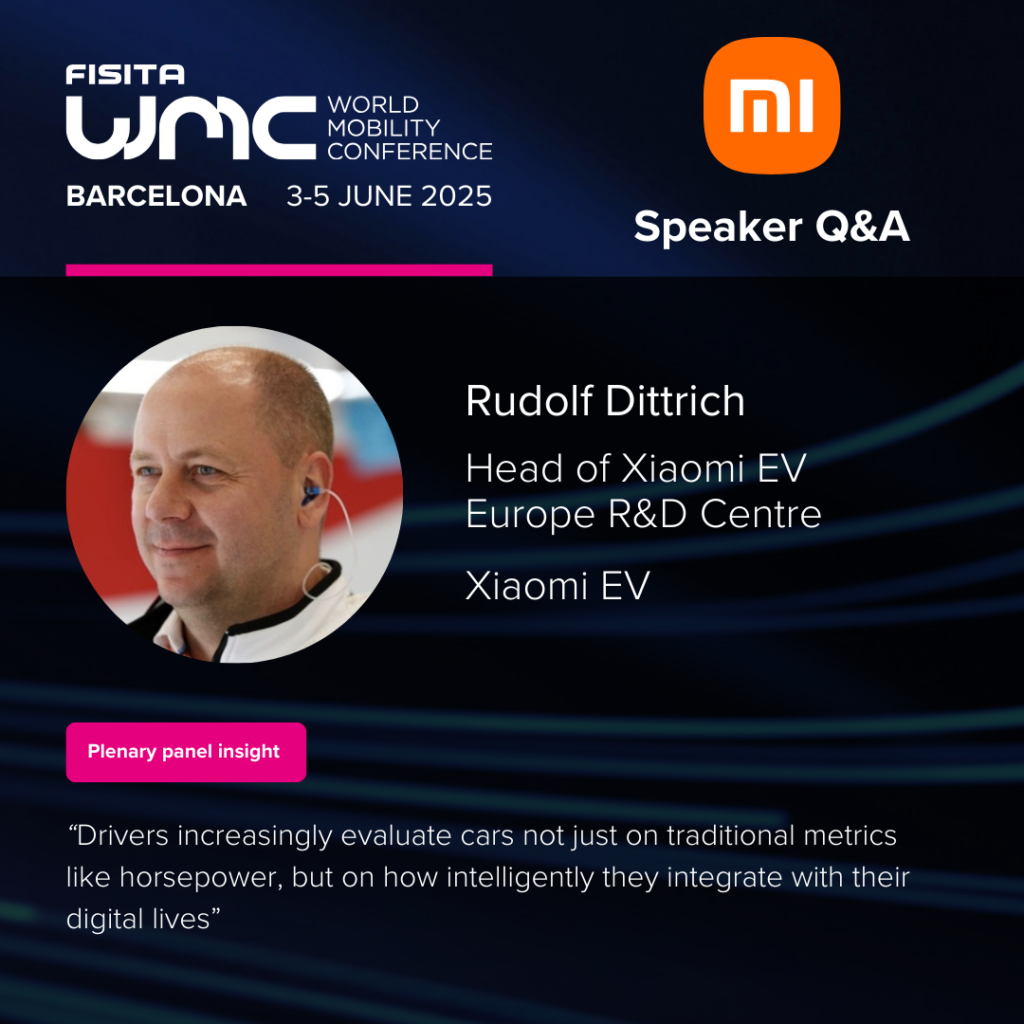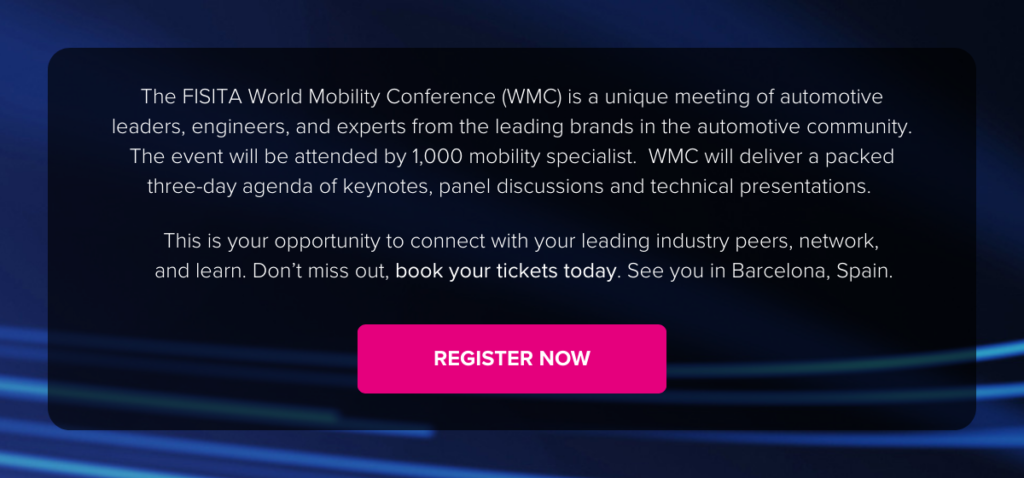Rudolf Dittrich, Head of Xiaomi EV Europe R&D Center, talks to FISITA CTO Martin Kahl about disruption in the automotive industry
“The future of mobility lies in vehicles that aren’t merely technologically advanced, but deeply context-aware, understanding and adapting to users’ lives far beyond the driving experience,” says Rudolf Dittrich, Head of Xiaomi EV Europe R&D Center.
At the FISITA World Mobility Conference in June 2025, Rudolf will participate in a plenary panel on “Industry disruption and the future of mobility,” alongside Ethan Sorrelgreen, Global Head of Product at Woven by Toyota, Lothar Schupet, Acting CEO, Zeekr Europe, and Pierre Millette, Chief Technology Officer at the European Automobile Manufacturers’ Association (ACEA).
Rudolf joined Xiaomi in 2024 and heads up the company’s R&D centre in Munich, not far from BMW where he spent over 15 years in various roles, many of which focused on motorsport. The role sees him developing electric vehicle technology for a company that until 2024 was known for being a major electronics manufacturer, a reputation that changed with the launch of the Xiaomi SU7 electric sedan line-up.
In this exclusive FISITA interview, Rudolf shares his views on disruption in the global automotive industry, and implications for the future of mobility.
Automotive is one of the most disruptive and disrupted industries; from a technical perspective, what do you expect will be the next big industry disruption in automotive and mobility?
Cars are a very emotional product category, and this emotional connection remains vital as we transition to intelligent, connected electric mobility devices. From a technological perspective, vehicle-to-everything, or V2X systems are a key area of development, enabling real-time communication between vehicles, infrastructure and energy grids to optimise both traffic flow and safety.
Drivers increasingly evaluate cars not just on traditional metrics like horsepower, but on how intelligently they integrate with their digital lives
Equally important is how we preserve and reinvent the emotional experience through smart interior systems that adapt to user needs and preferences. Alongside these developments, we’re seeing dynamic advances in propulsion technologies and production methodology that will continue to reshape the industry. This combination of technological innovation and emotional resonance will define the next phase of automotive evolution.
Automated drive technology has been highly disruptive, with automakers and suppliers racing to develop exciting enabling technologies, while questions around commercialisation, acceptance, liability, and regulatory compliance continue to hamper mainstream deployment. Where do you see automated driving fitting into the wider mobility ecosystem?
We are currently in a stage of rapid development in automated driving technology. At present, we are still at the stage of driver assistance and human-machine co-driving for most use cases. It will take some time before automated driving technology becomes widespread. Even though automated driving technology is rapidly advancing, its widespread adoption in mainstream passenger vehicles still faces commercialisation challenges. The most immediate applications will likely be in commercial and logistics operations—areas like freight transportation, delivery services, and ride-hailing, where the economic benefits can offset current technology costs most effectively. These focused applications will help build technological maturity and public acceptance while regulatory frameworks continue to develop.
How are software and artificial intelligence shaping vehicle development, and how much will software and AI change the way automakers and consumers conceive and perceive vehicles?
The automotive industry is fundamentally transforming as vehicles evolve from mechanical devices into intelligent, software-defined platforms. Across the industry, vehicles become continuously upgradable through over-the-air updates, much like smartphones, while AI enables unprecedented personalization through adaptive interfaces and predictive services. Perhaps most significantly, cars are transitioning from isolated transportation devices into connected hubs that intelligently interact with users’ broader digital ecosystems.
At Xiaomi, we’re advancing these trends through our “Human x Car x Home” smart ecosystem strategy. Our HyperOS platform creates seamless integrations where your EV might pre-warm automatically when detecting your departure from home, or maintain continuity of your entertainment preferences across devices. The system learns from your driving patterns and home behaviours to anticipate needs, whether adjusting cabin conditions or coordinating with your smart appliances.
The future of mobility lies in vehicles that aren't merely technologically advanced, but deeply context-aware, understanding and adapting to users' lives far beyond the driving experience
This represents a fundamental shift in how consumers perceive vehicles. Drivers increasingly evaluate cars not just on traditional metrics like horsepower, but on how intelligently they integrate with their digital lives. While many automakers build these capabilities individually, our existing ecosystem of over 200 connected product categories gives us a distinct advantage in delivering cohesive experiences spanning 95 percent of daily scenarios. The future of mobility lies in vehicles that aren’t merely technologically advanced, but deeply context-aware, understanding and adapting to users’ lives far beyond the driving experience.
With the development of new technologies and innovative business models, coupled with evolving views on vehicle ownership, what role will the passenger car play in the next generation of mobility?
The mobility landscape presents an interesting duality. While on-demand services are becoming increasingly available at competitive prices, personal vehicle ownership continues to show strong demand across many regions. This persistence of ownership stems from various factors, including consumer preferences for privacy, flexibility, and personal expression.
At the same time, technological advancements are enabling transformative new business models and vehicle capabilities. We’re seeing innovations ranging from bidirectional charging systems that turn vehicles into mobile energy storage units, to modular interior designs that can be reconfigured for work, entertainment, or relaxation. These developments are reshaping the fundamental role of passenger cars, evolving from purely personal mobility devices into multifunctional, connected spaces that can adapt to diverse needs while integrating with broader transportation networks.
The road ahead requires combining expertise from automotive, technology, energy, and policy domains to develop solutions that are not only technologically advanced but also practical and beneficial for society
This dual evolution ensures that while ownership models may evolve, the personal vehicle will remain relevant by offering traditional transportation benefits and new value-added capabilities.
You’re a panellist at the FISITA World Mobility Conference. What will be your key message to delegates?
The mobility industry stands at an inflection point, where cross-sector collaboration will be essential to address challenges and opportunities alike. Through the FISITA platform, we can forge meaningful partnerships across industries to accelerate smart mobility solutions while addressing pressing infrastructure and ethical AI considerations. The road ahead requires combining expertise from automotive, technology, energy, and policy domains to develop solutions that are not only technologically advanced but also practical and beneficial for society. By connecting with mobility leaders worldwide, we’re gaining strategic insights to shape sustainable mobility solutions aligning autonomy, electrification, and MaaS while maintaining safety, accessibility, and environmental responsibility, transcending geographical boundaries.

